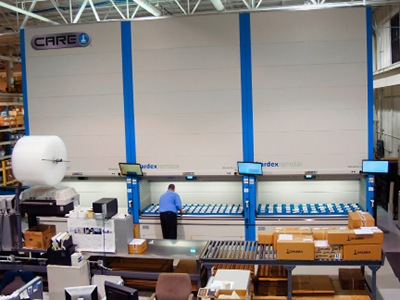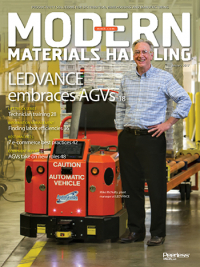Warehouse expands vertically to improve parts access and accuracy
Vertical lift modules replace a mezzanine to save space, increase speed and improve ergonomics.
Okuma is a world leader in CNC (computer numeric control) machine tools and controls with a “zero obsolescence” policy—they provide parts for every Okuma CNC machine ever made. Global inventory enables Okuma to achieve a service parts fill rate greater than 95%, meaning it’s likely the part the customer needs is on hand and ready for delivery. When the company installed vertical lift modules (VLM), it streamlined shipping and improved access to parts while saving space.
With more than $38 million in parts inventory, the company’s aftermarket parts facility in Charlotte, N.C., had a mechanical repair area in need of expansion. Mike Vassil, senior manager of service parts, considered two options: a building expansion or using vertical storage to decrease the warehouse footprint.
“As we researched, we found automated vertical storage would provide improved worker ergonomics and productivity, tighter inventory control and the space savings we were looking for,” Vassil says.
Three 18-foot-tall VLMs (Kardex Remstar) replaced a 1,200-square-foot mezzanine parts storage area. Occupying 400 square feet, the VLMs produced a 66% floor space savings.
The VLMs are integrated with inventory management software to provide tighter control and more accurate inventory counts. Warehouse employees must scan their badge before the machine will store or retrieve a part. Transaction logs and inventory reports are available to managers on demand. Replenishment is handled between the inventory management software and the enterprise resource planning (ERP) system. Minimum quantity levels are set and the system automatically generates reorder reports that are sent to procurement. Parts are received and replenished by the warehouse in the morning when order volume is lower.
“The renovation gives us better control of inventory accuracy and expedited shipping of parts,” Vassil says. “By streamlining storage and maximizing space in our warehouse, we were able to expand the mechanical repair area, increasing mechanical exchange capabilities to service more spindle and cam box repairs.”
The VLMs deliver all parts to the worker through an ergonomic access opening, eliminating walking, searching and stair climbing associated with the previous mezzanine shelving.
“Now workers are standing within 10 feet of every part,” Vassil says. “Removing excessive walking, bending and reaching from the parts fulfillment process has increased productivity and made the job easier for our warehouse staff, allowing us to easily maintain our 7 p.m. order cutoff time.”

Article Topics
Blogs News & Resources
60 Seconds with Bob Trebilcock, outgoing executive editor, Modern Materials Handling Learn from lift truck service history Two voices of reason on pallet materials The reBound Podcast: How Pitney-Bowes is innovating with autonomous vehicles. Packaging Corner: Be open to change 60 Seconds with Robert Martichenko of American Logistics Aid Network The reBound Podcast: Looking for talent in all the right places: How Essendant is revolutionizing recruitment More BlogsLatest in Materials Handling
Registration open for Pack Expo International 2024 Walmart chooses Swisslog AS/RS and software for third milk processing facility NetLogistik partners with Vuzix subsidiary Moviynt to offer mobility solutions for warehouses Materials Handling Robotics: The new world of heterogeneous robotic integration BSLBATT is looking for new distributors and resellers worldwide Lucas Watson appointed CSO for Körber’s Parcel Logistics business in North America Hyster recognizes Dealers of Distinction for 2023 More Materials HandlingAbout the Author
Subscribe to Materials Handling Magazine

Find out what the world's most innovative companies are doing to improve productivity in their plants and distribution centers.
Start your FREE subscription today.
April 2024 Modern Materials Handling

Latest Resources












